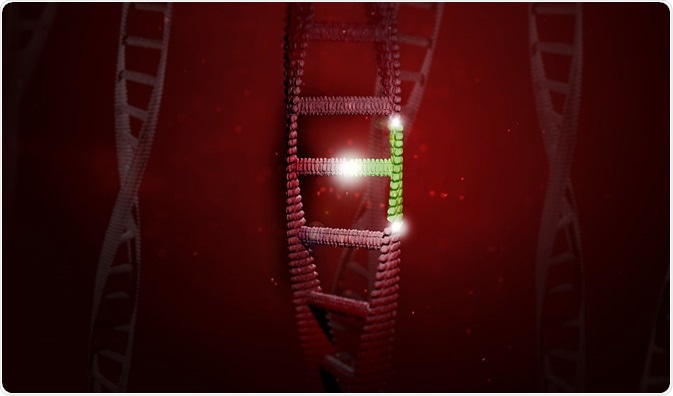Conditional gene knockout (CKO) is a technique that eliminates gene expression in a specific organ, tissue, or cell at a specific time.

Credit: Tobias Arhelger/Shutterstock.com
In traditional knockout studies, the gene is deleted altogether. However, deleting genes that are essential to embryonic development is lethal. Conditional gene knockout can be activated in an adult organism, enabling the study of developmental genes that may have different effects later.
CKO using mammalian embryonic stem (ES) cells
Conditional knockout in mammalian embryonic cells is carried out through homologous recombination. There are three site-specific recombination techniques that are commonly used in these cells:
Cre-loxP recombination
- The enzyme Cre (cyclization recombination) recombinase targets and cuts a DNA sequence and catalyzes recombination with another DNA locus (loxP).
- When a cell containing loxP sites in its genome expresses Cre, recombination takes place between those loxP sites. The specific recombination can be designed based on the orientation of loxP sites. If the same chromosome arm is carrying two loxP sites, sequential repeat of loxP causes a deletion event.
- LoxP sites that are inverted lead to an inversion event. If different chromosomes carry loxP sites, Cre will catalyze a translocation event. When Cre-recombinase is absent, loxP sites do not recombine.
Flp-frt recombination:
- Flp (flippase)-mediated recombination requires only Flp recombinase; a 423-amino acid monomeric peptide encoded within Saccharomyces cerevisiea, and FRT (Flp recombinase recognition target); a 34-base pair sequence flanking the gene of interest.
Dre-rox recombination:
- Dre is a site-specific recombinase similar to Cre, and its recombination targets sites are known as rox, rather than lox. The Dre-rox system is a comparable system to Cre-loxP, with no crossover recombination between Cre-rox or Dre-loxP.
CKO using gene editing enzymes
Gene editing systems like zinc finger nucleases (ZFNs), transcription activator-like effector nucleases (TALENs), and clustered regularly interspaced short palindromic repeat (CRISPR), are emerging alternatives to site-specific recombinases.
These enzymes have begun to replace many foundational methods in molecular biology such as cloning. Conditional gene knockout is another example where they have some advantages over the original tools.
ZFNs: ZFNs are recombinant protein domains composed of an N-terminal zinc-finger binding domain and effector nuclease domains. Zinc-finger domains are associated with transcription factors that recognize and bind specific DNA sequences. Nuclease domains are used to cleave the DNA strands.
TALENs: TALENs are sequence specific nucleases with a TAL effector domain that binds to a specific nucleotide sequence and an endonuclease domain that catalyzes a double-stranded break at the target site.
CRISPR: CRISPR-Cas9 is a robust tool for gene knockout due to its ease and simplicity. It uses RNA-guided DNA binding and sequence-specific cleavage of targeted DNA to edit DNA strands. The Cas9 protein induces double-stranded breaks at the genomic site of interest that can be repaired to inactivate gene mutations, or to conditionally knock out a gene.
CRISPR DNA Editing System In 90 Seconds
Credit: Science Insider/Youtube.com
Further Reading
Last Updated: Feb 26, 2019